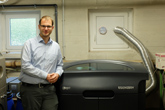- "It's now difficult to imagine life without our in-house 3D printing capability," says Michael Neumeier, Mechanical Design Engineer at HSVA
- 3D printing enables customized construction of scale-model prototype parts with complex geometrical shapes

Stratasys Ltd. (NASDAQ:SSYS), a leading global provider of 3D printing and additive manufacturing solutions has announced that Germany-based, Hamburg Ship Model Basin (HSVA), has significantly reduced the time and cost to produce bespoke prototype ship model components since introducing Stratasys additive manufacturing technology.
Having previously outsourced its 3D printing requirements, HSVA realized that further time savings and cost reductions could be achieved by bringing the technology in-house. Following the installation of the Objet Eden350V in 2013, the company has been able to quickly and cost-effectively produce strong, high performance plastic prototype parts while upholding its high standards of quality and precision.
 "A full-size ship is a complex geometric form with many complicated shapes that have to be re-produced true-to-scale," explains Michael Neumeier, Mechanical Design Engineer at HSVA. "To traditionally manufacture a prototype ship rudder in wood or plastic is a very skilled and labor-intensive job and typically takes up to three weeks to produce. With our Stratasys 3D Printer, we can produce parts within a day, which after cleaning, are ready for final assembly."
"A full-size ship is a complex geometric form with many complicated shapes that have to be re-produced true-to-scale," explains Michael Neumeier, Mechanical Design Engineer at HSVA. "To traditionally manufacture a prototype ship rudder in wood or plastic is a very skilled and labor-intensive job and typically takes up to three weeks to produce. With our Stratasys 3D Printer, we can produce parts within a day, which after cleaning, are ready for final assembly."
This extraordinarily short production time combined with minimal set up grants HSVA far more flexibility in dealing with customer requests - including the implementation of last minute changes. According to Neumeier, HSVA is also reaping the benefits of 3D printing within the production of the case for model azimuth propulsor drives (also known as "Pods"), one of the most advanced marine propulsion systems which are typically very difficult to produce and assemble. Due to the geometry of the 3D printed strut, the gearbox can easily be changed by removing just one part of the strut. This was too difficult with the traditionally produced milled strut connector, according to Neumeier.
"Being able to print the various parts on our Stratasys 3D Printer makes assembly much easier. This has seen us slash lead times by as much as 70 percent, which has resulted in significant cost reduction of around 30 percent," he adds.
Material properties meet rigorous testing requirements
All 3D printed components are produced in VeroGray, a rigid opaque material which provides excellent dimensional stability, great detail visualization and a sufficiently smooth surface quality. A unique combination of extreme precision and high material strength enables VeroGray models to withstand the rigorous testing procedures undertaken by the company.
"It's now difficult to imagine life without our in-house 3D printing capability", adds Neumeier. "Stratasys has been extremely supportive during installation, and the technology is now being used in almost every department. Not only have we cut lead times and costs, but the need for less human intervention throughout prototype production ensures maximum process stability and reliability.
"The integration of our additive manufacturing technology at HSVA in Germany and the incredible difference it is making to their design and production process is indicative of the efficiencies enjoyed by customers across a host of industries," says Andy Middleton, President of Stratasys EMEA. "Material advancements in particular enable the production of tough, realistic prototypes that can endure rigorous functional testing during the development phase."
The privately-managed and independent Hamburg Ship Model Basin (HSVA) has provided research and consultancy services to the worldwide maritime industry for over a century. The company has influenced and led developments of testing technology, methods, standardization and numerical procedures to solve complex hydrodynamical and structural problems during the development of new ships and other maritime objects.
www.stratasys.com










































































